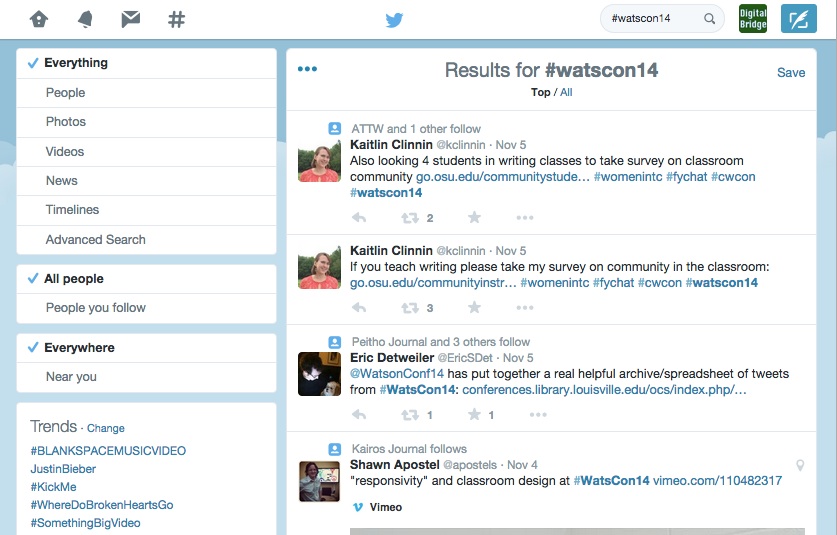An Overview of Twitter
Twitter is a Web 2.0 technology that offers users a unique way to access and share information, called tweeting, through the use of micro-blogging on computers, tablets, and phones. There are a number of facets of Twitter that distinguish it from other forms of social media and help inform its potential in an educational setting, some of which are pertinent to this investigation and require further explanation. The first aspect of Twitter is the baseline experience of all Twitter users (“users” applies to people, organizations, magazines, companies, political parties, etc.); users establish a “twitter handle” as their profile name—such as @benjamindally or @TIME—and then “Follow” other users in order to gain access to their tweets. Secondly, though tweets can only be 140 characters, Twitter also allows users to post links to websites as well as pictures. Thirdly, users may employee hashtags (#) to enter into the general discourse surrounding a topic, event, or idea on Twitter. During the 2012 Grammy Awards Ceremony, for example, the hashtag #GRAMMYs was tweeted 2.1 million times during the broadcast and allowed users to actively participate in the discourse surrounding the event (Jenn, 2012). Fourthly, users can tweet directly at other users by including their “twitter handle” in a tweet. A tweet directed at someone (called tweeting “@” them) goes into the Twitter feed but also notifies the member who has been tweeted @ to (perhaps) engender a response. Lastly, Twitter members can “retweet,” whereby they cite another user’s tweet. To offer a picture of how this scenario might unfold, an active Twitter member could log into Twitter on their mobile device, read a tweet by the New York Times, link to the full article to find out more information about the topic, and then, using the appropriate hashtag, enter into the discourse about that topic which is then retweeted by the New York Times. What emerges from this speaks to the participatory features inherent in Twitter and exemplifies how users interact with each other and society. Whereas in the past a person might have written a letter or email to the New York Times, now users are able to connect with the newspaper quickly, easily, and publically.
Web 2.0 and Twitter
To further the exploration of Twitter, it is important to understand Twitter as what O’Reilly Media has termed a “Web 2.0” technology. There are seven aspects of Web 2.0:
1) Services, not packaged software, with cost-effective scalability
2) Control over unique, hard-to-recreate data sources that get richer as more people use them
3) Trusting users as co-developers
4) Harnessing collective intelligence
5) Leveraging the long tail through customer self-service
6) Software above the level of a single device
7) Lightweight user interfaces, development models, AND business models. (O’Reilly, 2005)
Twitter should be understood as a Web 2.0 (O’Reilly, 2005) media. One of the defining characteristics of Web 2.0 is that it is centered on businesses; Web 2.0 technologies are established with the goal of maintaining or increasing a company's profit. With this in mind, it is important to understand the challenges and barriers that can result from the use of Web 2.0 in the classroom (Davis & Merchant, 2009). Twitter, Facebook, Linkedin, Instagram, and a host of other Web 2.0 technologies are, at their core, driven by commerce (Jenkins, 2013, p. xxii). Yet each of them exists within the overall umbrella of the emerging participatory culture.
In Web 2.0, users do not buy software that allows them to access, filter, and experience the web. Instead, users access and use the software through an internet site, which, among many other things, filters data and information for the user. The user’s content and experience is tied to, and influenced by, the content and experience of other users. In addition, since the developers control the data, then the developers guide the experience of the users. Web 2.0 technologies exemplify the changing scope of the internet. However, because Web 2.0 is highly interactive, it is well suited for academia and learning.
Yancey made clear in 2009 that, “With digital technology and, especially Web 2.0, it seems writers are *everywhere*—on bulletin boards and in chat rooms and in emails and in text messages, and on blogs responding to news reports and, indeed, reporting the news themselves as I-reporters (p. 4).” Whereas in the past, “[i]n school and out, writing required a good deal of labor” (Yancey, 2009, p. 2), today’s world is full of writers that are not afraid to voice their opinions, thoughts, and interests in writing. Writing has become as easy as the push of a few buttons. This new digital frontier brings with it new challenges and new opportunities. Clark (2010) suggests that more traditional models of composition are “giving way to a new era of digital rhetoric where, more than ever before, people are becoming authors every day, constructing digital profiles, public commentary, and using publicly available resources to research and inform their opinions” (p. 27).
When entering into discourse communities, the “relatively low barriers to artistic expression and civic engagement” (Jenkins et al. 2006) of Web 2.0 stand out as exemplifying academic potential. Students can express and engage in topics, thereby pulling real world topics and academic topics together. Yancey (2009) expresses the power of Web 2.0 to help students become “citizen composers” (p. 8). To accomplish this, students should engage with the reading on a personal level and try to connect it to the world that surrounds the reading and harness the “collective intelligence” mentioned by O’Reilly (2005).
The Activity System of Twitter
Russell (1997) defines an activity system as follows:
An activity system is any ongoing, object-directed, historically-conditioned, dialectically-structured, tool-mediated, human interaction: a family, a religious organization, an advocacy group, a political movement, a course of study, a school, a discipline, a research laboratory, a profession, and so on. (p. 510)
Each of the six aspects of an activity system can be clearly linked Twitter. To understand Twitter as an activity system, we can turn directly to the company itself. As a company, Twitter tries to emphasize qualities not traditionally associated with social networking as they attempt to rhetorically establish themselves as extra-social. In their initial public offering (IPO) paperwork, made public by the company, Twitter, Inc. highlights four elements of their service that they believe make them a part of the “evolving mobile ecosystem” (Form S-1, 2013). They claim that Twitter is: “Public” (“Twitter is open to the world”), “Real-Time” (“News Breaks on Twitter”), “Conversational” (“Users express themselves on Twitter”), and “Distributed” (“Tweets go everywhere”) (Form S-1, 2013). These four elements help outline Twitter as an activity system.
It is unarguable that Twitter is “Public” since anyone with an email address can set up a Twitter account and, in the default setting, tweets become public information. (If a user desires some amount of privacy, they must elect to be notified when someone wants to follow them and then can either accept or deny the request.) Firstly, this “Public” nature of Twitter causes it to be “historically-conditioned” (Russell, 1997, p. 510) as, over time, it is a product of “practices that have a history” (Kain & Wardel, 2006, p. 2) of use between many people. Secondly, the “Public” quality of Twitter causes it to rely very heavily on “human interaction” (Russell, 1997, p. 510) since it is an amalgamation of individuals that contribute to it who “work together, using tools [tweets], toward outcomes” (Kain & Wardel, 2006, p. 2).
Twitter’s “Conversational” nature allows it to be “dialectically-structured” (Russell, 1995, p. 55) as users all contribute not only to their own Twitter feed but also to the communal conversation through the use of hashtags (see Figure 7) which can be searched and sorted. Twitter users can search for a hashtag about a subject in which the are interested. As seen in Figure 7, a communal conversation has developed around the Thomas Watson Conference using the #WatsCon14. All updates about presenters, presentations, inforamation, images, videos, and much more which included the #WatsCon14 are searchable on Twitter. Users can then add to the communal conversation using the same hashtag. Replies between users and re-tweets of other users' information thereby cause the system to be “mutually-dependent” (Kain & Wardel, 2006, p. 2). This mutual dependence is enhanced by the “Distributed” quality of the Tweets and underscores the transaction (Kain & Wardel, 2006, p. 2) that occurs between users and the surrounding activity systems.

Figure 7. Hashtag search results
The “Real-Time” nature of Twitter highlights its “ongoing” (Russell, 1997, p. 510) character. It is a system that is continuously changing as users update their feed. Twitter is an ongoing system that is continually influenced by the users.
Twitter and Journalism
Unlike Facebook’s attention to user profiles, uploaded pictures, and comments, Twitter focuses on information. Pew Research Center’s survey (cited in Pew Research Center, para. 4, 2013b) conducted from August 21st, 2013 through September 2nd, 2013 found that “16% of U.S. adults use Twitter. Among those, roughly half (52%) 'ever' get news there — with news defined as 'information about events and issues that involve more than just your friends or family.'" Not only is Twitter a source of information, according to the survey, it is about more than just news related to those within a close social network. Additionally, it seems that journalists are using Twitter because “[f]or better or worse, it’s where news breaks today” (Klein, 2013). Since Twitter is where the most up-to-date news is for journalists, it seems likely that it is the most up-to-date news outlet for the average person as well. Though journalists might be more adept at navigating news provided on Twitter, it is still the fastest way to get real-time information. This also means that access and interaction are occurring on Twitter which directly connects to real-world events. Paul Farhi also discusses the relevance of Twitter with regard to news organizations and journalists:
In fact, Twitter can be a serious aid in reporting. It can be a living, breathing tip sheet for facts, new sources and story ideas. It can provide instantaneous access to hard-to-reach newsmakers, given that there’s no PR person standing between a reporter and a tweet to a government official or corporate executive. (2009, p. 28)
This “living, breathing tip sheet” allows journalists to interact directly with each other and the events they wish to write about.
